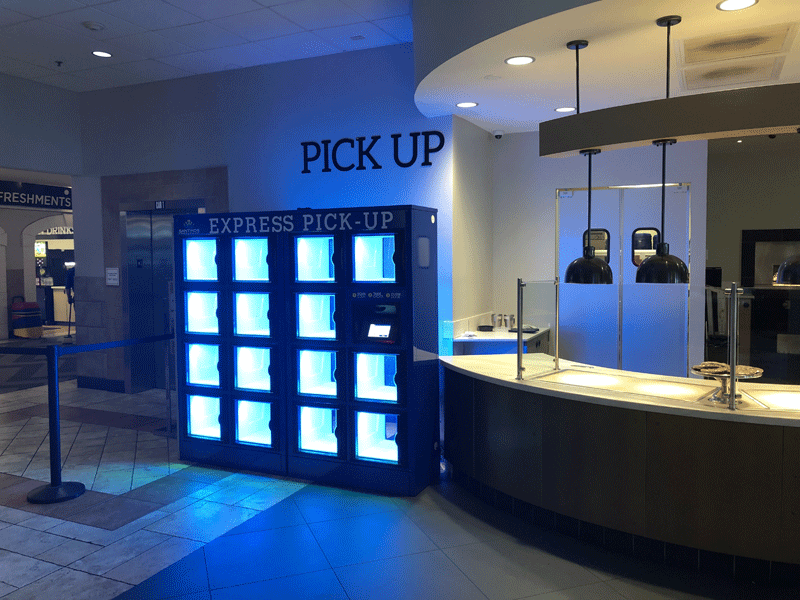In quick-service restaurants, where every second is scrutinized and monetized, taking out inefficiencies has been drilled down to the microscopic level. To reduce unnecessary human interaction and make it easier and faster for customers to pick up to-go orders, an industrial supply chain manufacturer has developed smart shelves that alert customers when their orders are ready, integrate directly with POS and shave off precious time for restaurants looking to boost their to-go business.
Based outside of Cincinnati, Apex Supply Chain Technology’s so-called Order Pick-up Solutions are a modern-day version of a restaurant to-go station, but they don’t require a dedicated employee to manage. The company’s smart shelves, which function much like Amazon’s lockers that allow customers to pick up orders outside of grocery stores or other high-traffic areas, provide real-time info both to the expo line and customers who want to avoid the line and quickly grab their to-go orders for a frictionless, person-less takeout experience.
The company’s Order Pick-Up technologies are part of its first foray into the foodservice world. Apex has deeper ties to the retail, warehouse, industrial, transportation and medical industries, but sees the changes happening in the restaurant and delivery spaces as a major opportunity to branch out and offer relatively low-cost solutions to restaurants looking to increase volume without adding to their already-challenging labor situation.
“It’s actually what we like to call ‘asynchronous handoff,’ and that’s really complex,” said Kimberly Carroll, Apex’s vice president of global marketing. “We provide technology solutions that enable self-serve pickup from something that may look like a locker or cabinet,” noting that there are several variants of the smart shelves. One of the most popular is a two-sided variant that allows back-of-the-house employees to place and secure finished meals with no customer interaction required.
Apex got into foodservice three years ago, and created the Little Caesars Pizza Portal that came out in 2018, bringing self-serve pickup to the Michigan-based pizza company’s thousands of U.S. locations. Like that application, the lockers can provide heat, but are also available in cooled models and can alert expo or kitchen staff when meals have passed their peak and need to be refired.
“Not only are consumers wanting things the way they would like it, but also our employees … sometimes don’t want to interact with consumers,” Carroll added about the restaurant side of the equation. “They can go ahead and place it directly into the locker, and the consumers receive a secure pickup code … so they know their order is going to be ready [and] they don’t have to wait in line.”
As the company looks to “open new pathways” into the restaurant world, Carroll said the company is looking at future growth areas in the restaurant world, which it views as a new, long-term vertical for the industrial giant. She added that the QSR category is especially intriguing, where seconds can make a massive difference in company-wide profits and guest satisfaction.
Addressing the company’s research on the restaurant-to-consumer relationship, Carroll said that providing enough flexibility and different locker formats was the key, as some restaurants had significantly different requirements—including the size of the devices or where they were placed, as well as the type of food being stored.
As third-party delivery drivers now add to the clutter around the host stand these days, Apex felt that diverting traffic away from that area was a critical priority, with the side benefit of reducing labor oversight for the customer pickup process.
Costs vary depending on size, features and placement, but Carroll said its products tend to be paid for as a monthly subscription, and are the equivalent of “two staff hours”–per day.
Compared with the Chicago-based Wow Bao brand where the only front-of-the-house employees direct consumers to a personalized pickup locker with animated screens that make the process a fun experience, the Apex units are less intricate. Instead, its units have a single screen that provides an opportunity for restaurant branding, but without the, “Hey, Tom, your order is ready!” song and dance. The company didn’t offer specifics, but said additional screens are a possibility for future iterations.
“Sometimes technology is absolutely a very cool factor, but sometimes it may be too much or it may be unnecessary,” Carroll added about future functionality. “We try to look at what would be commonly acceptable, what would be usable, and what would be wanted by every restaurant, because there’s a cost associated with that.”


